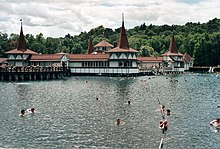Hévíz
| Hévíz | ||||
|
||||
| Basic data | ||||
|---|---|---|---|---|
| State : | Hungary | |||
| Region : | Western Transdanubia | |||
| County : | Zala | |||
| Small area until December 31, 2012 : | Hévíz | |||
| Coordinates : | 46 ° 47 ' N , 17 ° 11' E | |||
| Area : | 8.31 km² | |||
| Residents : | 4,335 (Jan 1, 2011) | |||
| Population density : | 522 inhabitants per km² | |||
| Telephone code : | (+36) 83 | |||
| Postal code : | 8380 | |||
| KSH kódja: | 03814 | |||
| Structure and administration (as of 2015) | ||||
| Community type : | city | |||
| Mayor : | Gábor Papp (Fidesz-KDNP) | |||
| Postal address : | Kossuth Lajos u. 1 8380 Hévíz |
|||
| Website : | ||||
| (Source: A Magyar Köztársaság helységnévkönyve 2011. január 1st at Központi statisztikai hivatal ) | ||||
The spa town of Hévíz [ ˈheːviːz ] is a small town in Hungary with about 4300 inhabitants in the Zala county . The place is about five kilometers from Lake Balaton northwest of the city of Keszthely .
history
Finds of Roman coins from the lake indicate that the area was settled almost 2000 years ago.
Research shows that Germanic and Slavic tribes also used the water at the time of the migrations .
Hévíz is first mentioned in 1328 as Locus vulgariter Hewyz dictus ( place called Hewyz by the people ).
The cure in its current form with the bathing operation has existed for over 200 years. In 1795, Count Feštetićs had the place expanded into a spa by building bath houses and spa facilities. The thermal bath was built between 1964 and 1968 and was damaged by fire in 1987. It was last renovated in 2006.
Since May 1, 1992 the place has been run as a city.
Today about 900,000 visitors visit the place every year. There are around 10,000 guest beds.
Thermal lake
With an area of around 4.4 hectares, the medicinal lake in Hévíz is the largest natural and biologically active thermal lake in the world, in which you can bathe all year round. This is fed by a thermal spring from a crater at a depth of 38 meters. With 410 liters per second, the spring is so productive that the water is completely exchanged within about 84 hours.
The water contains sulfur , carbon dioxide , calcium , magnesium and hydrogen carbonate and it has slightly radioactive properties. The thermal water should thereby contribute to relaxation of the body and thus to the success in the treatment of rheumatic and motor complaints. The water is used for stomach and digestive problems as well as for drinking cures . Furthermore, in winter the area above the water level becomes a huge open-air inhalatorium because of the strong development of steam. These vapors are said to have a beneficial effect on the vocal cords .
The mud from the bottom of the lake is also used for physiotherapeutic measures. It contains both organic and inorganic components, the most important of which are sulfur solutions and radium salts.
The water temperatures of the lake are around 33 to 36 ° C in summer and around 23 to 25 ° C in winter. This enables year-round swimming in the open air. The thermal bath is open daily.
Public transport connections
- Public bus to Keszthely
- Bus connection with major cities in Hungary
- Flights from Germany to Hévíz-Balaton Airport ( Airport Balaton )
Attractions
- Dr. Vilmos Promenade Schoolyard
- Pedestrian zone
- town hall
- Church from the Arpad period
- Sacred Heart Church
- Roman Catholic Holy Spirit Church
- Evangelical Reformed Church
- Kind of cinema
- Museum collection
- Buffet row
- Egregy wine cellar
- Egregy Museum
- Roman soldier's tomb
- Roman ruins garden
- Hévíz farmers market
Town twinning
- Herbstein , Germany since 1995
- Pfungstadt , Germany since 2005
- Pyatigorsk , Russia since 2012
- Guilin, China since 2012
- Čazma, Croatia
- Sarm al-Seikh, since 2013
- Fethiye, Turkey since 2015
gallery
Web links
- Official website
- Hévíz Virtual Tour - Spherical Panorama Pictures, Hévíz Video Portal (Hungarian, English)
- The spa offer of Hévíz
Individual evidence
- ↑ The history of Bad Héviz on www.badheviz.de
- ↑ Hot springs, dark tunnels - The thermal lake of Héviz. ( Memento of October 9, 2010 in the Internet Archive ).
- ↑ Гости из венгерского Хевиза поздравляют город-побратим с 238-летием , pyatigorsk.org , September 8, 2018 (Russian)







